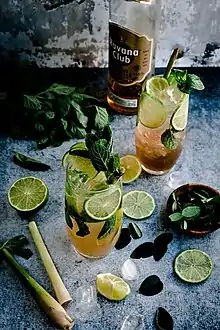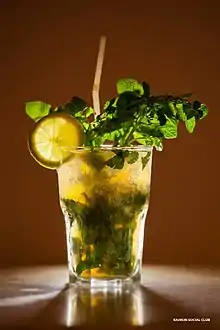Mojito
Mojito (/moʊˈhiːtoʊ/; Spanish: [moˈxito]) is a traditional Cuban highball. The cocktail often consists of five ingredients: white rum, sugar (traditionally sugar cane juice), lime juice, soda water, and mint.[1][2] Its combination of sweetness, citrus, and herbaceous mint flavours is intended to complement the rum, and has made the mojito a popular summer drink.[3][4]
| IBA official cocktail | |
|---|---|
 | |
| Type | Cocktail |
| Primary alcohol by volume | |
| Served | On the rocks; poured over ice |
| Standard garnish | sprig of mint (Yerba buena in the original recipe), slice of lime |
| Standard drinkware | |
| IBA specified ingredients |
|
| Preparation | Muddle mint leaves with sugar and lime juice. Add a splash of soda water and fill the glass with cracked ice. Pour the rum and top with soda water. Garnish with sprig of mint leaves and lemon slice. Serve with straw. |
When preparing a mojito, fresh lime juice is added to sugar (or to simple syrup) and mint leaves. The mixture is then gently mashed with a muddler. The mint leaves should only be bruised to release the essential oils and should not be shredded.[5] Then rum is added and the mixture is briefly stirred to dissolve the sugar and to lift the mint leaves up from the bottom for better presentation. Finally, the drink is topped with crushed ice and sparkling soda water. Mint leaves and lime wedges are used to garnish the glass.

The mojito is one of the most famous rum-based highballs. There are several versions of the mojito.[6]
History
Havana, Cuba, is the birthplace of the mojito,[7][8][9][10][11] although its exact origin is the subject of debate. It was known that the local South American Indians had remedies for various tropical illnesses, so a small boarding party went ashore on Cuba and came back with ingredients for an effective medicine. The ingredients were aguardiente de caña (translated as "burning water", a crude form of rum made from sugar cane) mixed with local tropical ingredients: lime, sugarcane juice, and mint.[12] Lime juice on its own would have significantly prevented scurvy and dysentery,[13][14][15] and tafia/rum was soon added as it became widely available to the British (ca. 1650). Mint, lime and sugar were also helpful in hiding the harsh taste of this spirit. Another theory is that it was invented by Sir Francis Drake. The "El Draque" cocktail was prepared with brandy.[16] While this drink was not called a mojito at this time, it was the original combination of these ingredients.[4]
Some historians contend that African slaves who worked in the Cuban sugar cane fields during the 19th century were instrumental in the cocktail's origin.[17] Guarapo, the sugar cane juice often used in mojitos,[4] was a popular drink among the slaves who named it.[17] It never originally contained lime juice.[18][19]
There are several theories behind the origin of the name mojito: one such theory holds that name relates to mojo, a Cuban seasoning made from lime and used to flavour dishes.[4][20] Another theory is that the name Mojito is simply a derivative of mojadito (Spanish for "a little wet"), the diminutive of mojado ("wet").[21]
The mojito has routinely been presented as a favorite drink of author Ernest Hemingway.[22] It has also often been said that Hemingway made the bar called La Bodeguita del Medio famous when he became one of its regulars and wrote "My mojito in La Bodeguita, My daiquiri in El Floridita" on a wall of the bar. This epigraph, handwritten and signed in his name,[23] persists despite doubts expressed by Hemingway biographers about such patronage and the author's taste for mojitos.[24] La Bodeguita del Medio is better known for its food than its drink.[25][26]
A survey by an international market research company found that in 2016 the mojito was the most popular cocktail in Britain and France.[27]
Variations
Many hotels in Havana also add Angostura bitters to cut the sweetness of the Mojito; while icing sugar is often muddled with the mint leaves rather than cane sugar, and many establishments simply use sugar syrup to control sweetness.[28] Many bars today in Havana use lemon juice rather than fresh lime. The "Rose Mojito," which is a Mojito variation containing the rose-flavored spirit, Lanique, was first created at the Albert's Schloss bar in Manchester, England.[29] A Mojito without alcohol is called a "Virgin Mojito" or "Nojito".[30] The Cojito adds coconut flavor, often through the use of coconut-flavored rum.[31] The South Side is made with gin instead of rum; the South Side Fizz adds seltzer water. A dirty mojito calls for gold rum instead of white rum and to use raw sugar or demerara sugar.[32] Demerara is a light brown, partially refined, sugar produced from the first crystallization during processing cane juice into sugar crystals. Adding this to a mojito gives it a caramel-like flavor.[33] A dark rum mojito simply calls for a dark rum to be used instead of white.[32]
In Mexico, tequila brand Don Julio offers the "Mojito Blanco" by simply replacing rum with tequila.[34]
In Peru, there are mojito variations that are made by adding fruits like grapefruit, called "Mojito de toronja",[35] or with passionfruit, called "Mojito de maracuyá".[36] Many restaurants serve them,[37][38] and these added ingredients enhance the cocktail and its original flavor. Some other fruits are found in other mojito recipes: pears, raspberries, and oranges.[32] Purees of such fruits may also be used instead of the whole fruit itself.
The strawberry mojito includes muddled strawberries;[39] a further departure along these lines substitutes gin for the light rum and lemon juice for lime juice, and adds tonic.[40]
See also
- Caipirinha
- List of cocktails
- Mint julep
- Rum Punch
- Grog is a mix of water, rum and lime, given as rations to British sailors in the 18th Century.
 Liquor portal
Liquor portal
References
- "Traditional Mojito recipe from Cuba". Tasteofcuba.com. Archived from the original on 2011-09-04. Retrieved 2011-09-01.
- Colleen Graham; About.com Guide (2011-06-11). "About.com Mojito". Cocktails. about.com. Retrieved 2011-09-01.
- "Summer Cocktail News: Mojitos Go Fruity". Prweb.com. 2008-06-04. Retrieved 2011-09-01.
- Fernandez, Maria Elena (2001-08-12). "Shake It Up, Baby: Cuban Cocktail Is Making a Splash". Los Angeles Times. Retrieved 16 May 2017.
- Fumi. "How to Muddle a Mojito". Wasabibratwurst.com. Archived from the original on 2011-08-11. Retrieved 2011-09-01.
- "Havana-Club - the real Mojito and Daiquiri Cuban Rum Cocktail: Recipe of the Mojito Cocktail". Archived from the original on 2008-04-30. Retrieved 2008-05-27.
- Staff, Liquor com. "Explore the Mojito's Captivating and Delectable History". Liquor.com. Retrieved 2020-01-08.
- "The History of the Mojito". TASTE cocktails. 2015-07-26. Retrieved 2020-01-08.
- Chowhound. "The (Hotly Debated) History Behind the Mojito". Chowhound. Retrieved 2020-01-08.
- "Mojito Cocktail". diffordsguide.com. Retrieved 2020-01-08.
- "Tres Famosos Cocteles Celebran Su Día". Havana Club. Retrieved 11 July 2020.
- Burkhart, Jeff (2012). Twenty Years Behind Bars: the spirited adventures of a real bartender (1st ed.). PhotoCine Media. ISBN 9780985500115.
- Maratos, David (7 July 2010). "How The El Draque Cocktail May Have Helped Britannia Rule The Waves". GoArticles. Archived from the original on 4 March 2016.
- Maratos, David (16 June 2012). "The 1st Cocktail, Invented 1586 Was A Medicinal Crude Rum Mix (Article 34)". Archived from the original on 28 September 2012.
- "Tres Famosos Cocteles Celebran Su Día". Havana Club. Retrieved 11 July 2020.
- "Tres Famosos Cocteles Celebran Su Día". Havana Club. Retrieved 11 July 2020.
- "Mojito History". Mojitocompany.com. Archived from the original on 12 April 2009.
- Roberts, Walter Adolphe (1948). Lands of the inner sea, the West Indies and Bermuda. New York: Coward-McCann. p. 21.
- Sky juice and flying fish: traditional Caribbean cooking by Jessica B. Harris in 1991
- Mojito is derived from the Spanish mojo sauce, which often contains lime juice (see "mojito" at Dictionary.com, citing the American Heritage Dictionary of the English Language, Fourth Edition, 2006, Houghton Mifflin), while mojo is derived from the Spanish verb mojar, meaning "to make wet" (see definition 3 of "mojo" at Dictionary.com, citing Webster's New Millennium Dictionary of English, Preview Edition (v 0.9.7), 2003–2007, Lexico Publishing Group, LLC)
- Shenton, Will (2016-07-11). "The History of the Mojito". Bevvy.co. Retrieved 2016-09-27.
- "Great American Writers and Their Cocktails". NPR.org. 2006-12-15. Retrieved 2009-06-05.
- W. Stock on August 8th, 2010 (2011-02-19). "Die ewige Bodeguita". Stockpress.de. Retrieved 2011-09-01.
- Greene, Philip (2012). To Have and Have Another: A Hemingway Cocktail Companion. Perigee Trade. p. 168. ISBN 978-0399537646.
- Menu, La Bodeguita del Medio, Habana, Cuba in 1959
- All around the world cookbook – Page 282 by Sheila Lukins in 1994
- "Global cocktail consumption highlights opportunity for British bars and suppliers". International Cocktail Report. CGA Strategy. 13 July 2016. Archived from the original on 29 June 2017. Retrieved 16 May 2017.
- "Food: Mojito". The Austin Chronicle. 2006-08-18. Retrieved 2011-09-01.
- "Cocktails in the City Comes Back to Manchester". DrinksEnthusiast.com. Drinks Enthusiast.
- Gee, Denise. "Nojito Recipe". Epicurious.com. Retrieved 2011-09-01.
- Petrosky, Maureen (5 September 2016). "Pitcher cocktail for your Labor Day party: sparkling Cojito". The 10-Minute Happy Hour. Kitchn. Archived from the original on 2017-06-13. Retrieved 2017-11-01.
- "10 Mojito Variations – Rum Therapy".
- "What is Demerara Sugar? - Care2 Healthy Living". Healthy Living. Archived from the original on 2018-07-15. Retrieved 2019-02-04.
- "Blanco Mojito Drink - Tequila Drink Recipe - Don Julio". donjulio.com.
- "Mojito de toronja". Perú.com.
- "Mojito de Maracuyá - La Despensa de Don Juan". ladespensadedonjuan.com.sv.
- "Foto de Madam Tusan, Lima: MOJITO DE MARACUYA Y JUGO DE CHIRIMOYA, FRESA Y MANDARINA - TripAdvisor". tripadvisor.com.pe.
- "Foto de New York Burger, Lima: Mojito de Maracuya - TripAdvisor". tripadvisor.com.pe.
- https://www.callmepmc.com/strawberry-mojito/
- https://www.callmepmc.com/strawberry-gin-mojito/
External links
| Wikimedia Commons has media related to Mojito. |
| The Wikibook Bartending has a page on the topic of: Mojito |